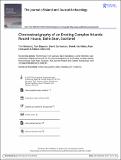Files in this item
Chronostratigraphy of an eroding complex Atlantic Round House, Baile Sear, Scotland
Item metadata
| dc.contributor.author | Kinnaird, Tim | |
| dc.contributor.author | Dawson, Tom | |
| dc.contributor.author | Sanderson, David | |
| dc.contributor.author | Hamilton, Derek | |
| dc.contributor.author | Cresswell, Alan | |
| dc.contributor.author | Rennell, Rebecca | |
| dc.date.accessioned | 2017-11-24T11:30:06Z | |
| dc.date.available | 2017-11-24T11:30:06Z | |
| dc.date.issued | 2017-11-07 | |
| dc.identifier | 251488920 | |
| dc.identifier | 7fd6d055-9abc-4b6b-9a09-df483bd1d3a2 | |
| dc.identifier | 85033371192 | |
| dc.identifier | 000469997800003 | |
| dc.identifier.citation | Kinnaird , T , Dawson , T , Sanderson , D , Hamilton , D , Cresswell , A & Rennell , R 2017 , ' Chronostratigraphy of an eroding complex Atlantic Round House, Baile Sear, Scotland ' , The Journal of Coastal and Island Archaeology , vol. Latest Articles . https://doi.org/10.1080/15564894.2017.1368744 | en |
| dc.identifier.issn | 1556-1828 | |
| dc.identifier.other | ORCID: /0000-0002-9229-7942/work/66591808 | |
| dc.identifier.uri | https://hdl.handle.net/10023/12166 | |
| dc.description | The excavation team would like to thank Historic Scotland (now Historic Environment Scotland) and the University of St Andrews for providing funding. | en |
| dc.description.abstract | A high-resolution chronostratigraphy has been established for an eroding Atlantic round house at Sloc Sàbhaidh (North Uist, Scotland), combining detailed OSL profiling and dating of sediments encompassing the main bracketing events associated with the monument, radiocarbon AMS dates on bone recovered from excavated features and fills within it, and TL dates on pottery and burnt clay. Concordant OSL and radiocarbon evidence place construction of the wheelhouse in the first to second centuries AD, contemporary with dates from the primary occupation. Beneath the wheelhouse, clay deposits containing burnt material, attest to cultural activity in vicinity to the monument in the preceding second to first centuries BC. At a later date, the southern wall collapsed, was rebuilt, and the interior spaces to the monument re-structured. The chronology for the later horizons identified from the sediment luminescence dates extends to the second half of the first millennium AD, which goes beyond the range of the radiocarbon dates obtained. The data from ceramics encompass both periods. The juxtaposition of the dating evidence is discussed relative to short and longer chronologies for this Iron Age monument. Corollaries of this research are the implications that based on the long chronology, some of the ecofacts (bone) appear to be residual, and that the temporal duration of Hebridean Coarse Ware may extend into the second half of the first millennium AD. | |
| dc.format.extent | 15 | |
| dc.format.extent | 1254270 | |
| dc.language.iso | eng | |
| dc.relation.ispartof | The Journal of Coastal and Island Archaeology | en |
| dc.subject | Chronology | en |
| dc.subject | Geoarchaeology | en |
| dc.subject | Household archaeology | en |
| dc.subject | CC Archaeology | en |
| dc.subject | GE Environmental Sciences | en |
| dc.subject | NDAS | en |
| dc.subject.lcc | CC | en |
| dc.subject.lcc | GE | en |
| dc.title | Chronostratigraphy of an eroding complex Atlantic Round House, Baile Sear, Scotland | en |
| dc.type | Journal article | en |
| dc.contributor.institution | University of St Andrews. School of Earth & Environmental Sciences | en |
| dc.contributor.institution | University of St Andrews. School of History | en |
| dc.contributor.institution | University of St Andrews. Scottish Oceans Institute | en |
| dc.identifier.doi | https://doi.org/10.1080/15564894.2017.1368744 | |
| dc.description.status | Peer reviewed | en |
This item appears in the following Collection(s)
Items in the St Andrews Research Repository are protected by copyright, with all rights reserved, unless otherwise indicated.

